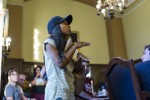Imagine navigating a public university in which students of your ethnicity make up less than 5 percent of the undergraduate student body. Imagine your university experience plagued by things like parties centered around racially insensitive costumes and a photograph of your undergraduate student government president throwing up a gang sign like it means nothing.
And now, imagine reaching out to the administration twice in less than two years to express your community’s needs.
This is a reality for black students here at UCLA.
Racism is nothing new here at UCLA. A few weeks ago, the Afrikan Student Union called on the administration to fulfill eight demands after a leaked photo surfaced of the former undergraduate student government president flashing a gang sign. ASU is now in talks with the administration to address these demands.
Most notably, ASU has proposed creating a Black Resource Center. Alicia Frison, a fourth-year African American Studies student and ASU chairperson, said the center would support ASU’s programming and give it a place to host its general body meetings on campus. She added it would help foster a more inclusive environment for black students.
UCLA needs to seriously consider creating this center. The administration has a responsibility to meet the needs of its marginalized communities, and a Black Resource Center is a pressing need for the black community.
Frison said the Black Resource Center could help support projects like the Academic Supports Program, Students Heightening Academic Performance through Education and the African Education Project. These programs focus on retention and providing students the help they need to succeed in college, but a centralized resource center could help enhance their ability to fulfill their missions.
This center would help students of color apply to UCLA, since it would be offering more programs that benefit their communities. And that’s in the school’s best interest, too: UCLA would have demonstrated a commitment to diversity and inclusion by creating a center dedicated solely to that.
The administration may not be entirely on board with this proposal, however. The administration has met with ASU several times in the past about previous demands, but were quite selective with which ones to address.
Moreover, it appears to not have a clear idea of how to even go about allowing marginalized communities to create centers on campus.
“We strive to create a diverse learning and working environment where all are respected, included, valued and treated equally,” said Tod Tamberg, UCLA’s director of strategic communications, in an email statement.
However, the Student Affairs office, which is meant to connect students with programs and services offered around campus, had little information about how a student group would go about securing funding and space. I personally was redirected five times by the office before a media spokesperson told me the process was too complicated to disclose – hardly a sign of glowing transparency.
This sort of vague behavior is discouraging. UCLA should be more direct and stop beating around the bush when students are seeking information about creating a center for supporting marginalized communities, like the one proposed by ASU.
UC Berkeley and UC San Diego have already created similar centers for African American students. It’s not too far-fetched to think that UCLA, a sister campus with similar resources, could do the same.
And certainly, finding space on campus is no easy task, but the administration has a history of ignoring ASU’s demands, like its call for an anti-discriminatory policy which would introduce more severe consequences for discriminatory behavior, and for hiring more black faculty across the different academic disciplines. Finding space for a center is possible – but the administration actually has to make an effort this time.
UCLA has to deal with many requests for spaces on campus since it has to go through an extended process of not only finding space, but also allocating the necessary funds for these groups. But simply providing adequate information, not misdirecting students, listening to their concerns and taking concrete action can go a long way.
And no, creating a center is not a form of segregation, despite how some like to describe it. Rather, it is a space for the black community to feel safe on campus and come together. It’s about supporting the community’s many projects for improving students’ collegiate experiences. And it’s about time that UCLA begins to do something for this community.
It is only after creating these centers for marginalized groups that UCLA will be the diverse community it so claims to be. And sure, the university has a long way to go before marginalized communities are no longer marginalized.
But that’s no excuse for running students around in circles when they ask for space on campus.

“…parties centered around racially insensitive costumes and a photograph of your undergraduate student government president throwing up a gang sign…”
I knew things were bad, but I didn’t know that they were this bad. No wonder you are all melting.
Racist blacks always demand special privileges.
I’m just interested in why you deem ASU as “racist blacks”. And considering the vast history of black people in general and black students on this campus being significantly disadvantaged due to systematic oppression, do you still believe that black students on this campus aren’t rightfully deserving of these so called “special privileges”? I think what these “blacks” (and to correct you, “blacks” sounds incredibly dehumanizing, I would suggest you say “black people”) are looking for, to put it simply, is equity.
The black supremacists are the ones demanding separate dorm rooms. The black supremacists are the ones threatening administrators until they get their way. Black supremacists are the ones who think they’re still disadvantaged. The truth is that none of them were denied a seat at the lunch counter. None of them were denied the right to vote. None of them were refused entry into school.